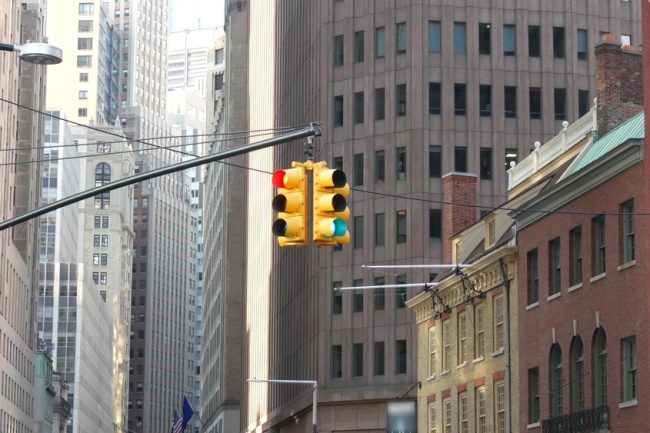
For over a century, the language of traffic lights has been simple. Red means stop, green means go, and yellow means hurry up (or slow down, depending on your personality). This system has worked pretty well for cars driven by humans. But the future of driving is about to change everything.
Researchers are preparing for a world where autonomous vehicles (AVs) share the road with the rest of us. To make that transition safer and more efficient, they’ve proposed a radical idea. It’s time to add a fourth color to our traffic signals. This new traffic light color isn’t just a concept; it’s a practical solution for a high-tech problem.
Why Do We Even Need a Fourth Color?
The problem is coordination. Self-driving cars have the potential to communicate with each other and with the traffic infrastructure itself. This technology, called vehicle-to-infrastructure (V2I), allows AVs to work together. They can optimize traffic flow in ways human drivers simply can’t.
However, there will be a long transition period. During this time, both AVs and human-driven cars will be on the road. The new fourth light is designed to be a bridge. It will help human drivers understand what the network of AVs is doing.
Introducing: The White Light
Researchers from North Carolina State University have proposed a “white light” phase. This isn’t a universally agreed-upon color, as some suggest turquoise or another distinct hue. The key is that it’s a fourth, easily recognizable signal. This white light would tap into the computing power of autonomous vehicles.
Think of it as a signal for human drivers to follow the leader. The white light indicates that the AVs are managing the intersection. Your job is simply to follow the car in front of you. It’s a fundamental shift in how we interact with traffic flow.
What Does the White Light Actually Mean?
When the white light is active, human drivers should do one thing: follow the car ahead of them. If the car in front of you goes through the intersection, you go. If the car in front of you stops, you stop. You are essentially handing over control to the coordinated group of AVs.
This concept relies on the AVs to communicate with each other. They can determine the most efficient way to get everyone through the intersection. This could mean letting a platoon of cars from one direction go, then another. The red, yellow, and green lights would still operate when there are fewer AVs in the area.
The Power of Vehicle-to-Infrastructure Communication
This new traffic light color is only possible because of connected vehicle technology. Autonomous cars can broadcast their position and intended path. The traffic signal, acting as a central computer, can process this information. It then makes the optimal decision for the entire group of vehicles.
This system can account for traffic density, speed, and direction. It avoids the rigid timing of traditional traffic lights. The result is a more fluid and responsive traffic management system that adapts in real-time.
How It Could Make Your Commute Faster
Stop-and-go traffic is a major cause of delays. Traditional traffic lights can contribute to this by stopping cars unnecessarily. A coordinated system led by AVs can smooth out these patterns. By keeping cars moving, even at a slower but steadier pace, the system can significantly reduce travel time.
Simulations have shown that this “white phase” approach can reduce delays substantially. The more AVs on the road, the greater the benefit. Even a small number of AVs can positively impact the flow of traffic for everyone.
It’s Also a Major Win for Safety
Intersections are hotspots for accidents. Many of these are caused by human error, such as running a red light or misjudging a gap. By allowing a computer to manage the flow of traffic through a complex intersection, we can reduce the potential for these mistakes.
The white light system creates a more predictable environment. Human drivers have a simple instruction to follow. This reduces the cognitive load and potential for error, making intersections safer for cars, cyclists, and pedestrians alike.
When Will You See These New Lights?
Don’t expect to see a white light on your commute tomorrow. This technology is still in the research and development phase. It requires a significant number of autonomous vehicles on the road to be effective. It also requires a massive investment in smart infrastructure across the country.
However, the concept is gaining traction. Pilot programs and test beds are likely to be the first places we see this new traffic light color in action. As AV technology becomes more common, the need for this kind of innovative traffic management will only grow.
The Future of the Open Road is Smarter
The introduction of a new traffic light color is more than just a novelty. It represents a fundamental shift in our relationship with driving. We are moving from a system of individual human decisions to one of coordinated, computational efficiency. It’s a glimpse into a future where our cities are smarter, safer, and less congested.
This change won’t happen overnight. But the conversation has begun. The simple trio of red, yellow, and green is about to get a much-needed, high-tech update.
What do you think about this new traffic light color? Drop your thoughts in the comments!
What to Read Next…
- 9 Ways Living at Home as an Adult is Actually Helping Your Future
- Why Do Some Men Treat Cars Better Than Relationships?
- 9 Travel Experiences That Teach Women Safety Lessons
- The Female Nomad’s Guide to Traveling
- 10 Hidden Costs of Pretending Everything’s Fine in a Broken Relationship

Latrice is a dedicated professional with a rich background in social work, complemented by an Associate Degree in the field. Her journey has been uniquely shaped by the rewarding experience of being a stay-at-home mom to her two children, aged 13 and 5. This role has not only been a testament to her commitment to family but has also provided her with invaluable life lessons and insights.
As a mother, Latrice has embraced the opportunity to educate her children on essential life skills, with a special focus on financial literacy, the nuances of life, and the importance of inner peace.







